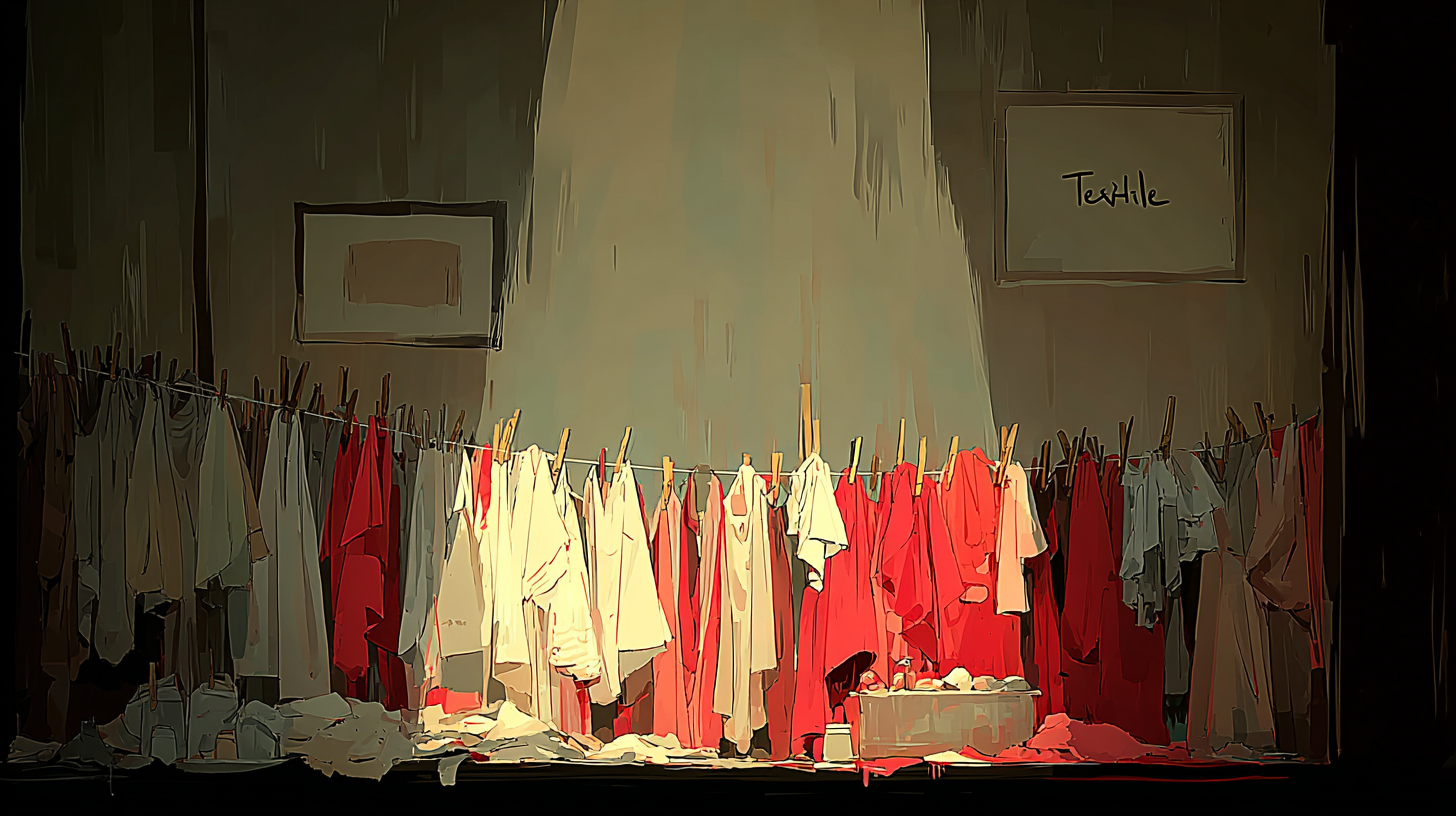“Textile” means cloth or fabric used to make clothes or other items.
「textile」は、服や布などを作るための「布」や「織物」を意味します。
以下は英単語 “textile” に関するストーリー型学習コンテンツです。まずは大枠の意味を理解して最後の文章で確認しましょう。
「textile」の主な意味(main meaning)
| 品詞 | 意味 | 発音記号 | 英文例 |
|---|---|---|---|
| noun | 織物、生地 | /ˈtek.staɪl/ | The factory produces high-quality textiles for clothing. |
「textile」の語源(etymology)
ラテン語 texere(編む、織る)から来ています。
→ 「糸を組み合わせて作るもの」というイメージ。
「textile」の類義語(synonyms)
| 類義語 | 意味 | 例文 |
|---|---|---|
| fabric | 布、生地 | This fabric is soft and easy to sew. |
| cloth | 布 | She bought a piece of cloth to make curtains. |
| material | 材料、生地 | The material feels smooth and light. |
| fiber | 繊維 | Cotton is a natural fiber used in many textiles. |
| garment | 衣類 | The garment industry depends on good textiles. |
「textile」の反義語(antonyms)
| 反義語 | 意味 | 例文 |
|---|---|---|
| metal | 金属 | Unlike textiles, metal is hard and cold. |
| plastic | プラスチック | Some products are made of plastic instead of textiles. |
「textile」のコロケーション(collocations)
| コロケーション | 例文 |
|---|---|
| textile industry | The textile industry is important for the local economy. |
| textile factory | He works in a textile factory near the city. |
| textile designer | My sister dreams of becoming a textile designer. |
| textile production | Textile production requires skilled workers. |
| synthetic textile | Synthetic textiles are often cheaper than natural ones. |
「textile」の2項表現(binomials)
| 2項表現 | 例文 |
|---|---|
| warp and weft | The pattern depends on the warp and weft of the cloth. |
| needle and thread | She used needle and thread to repair the textile. |
英語ストーリー(english story)
Title: A New Life in the Textile Factory
When Mia moved to the city, she had only one dream—to find a job that would allow her to support her family. After many weeks of searching, she finally got a position at a textile factory. The factory was old but famous for its high-quality fabrics (布) and materials (材料).
On her first day, Mia was nervous. The machines were loud, and the air smelled of cotton and oil. Her supervisor, Mr. Tanaka, showed her how to check the fibers (繊維) before they were woven into textiles (織物). “Every thread must be perfect,” he said. “Even one weak fiber can ruin a whole piece of cloth (布).”
Mia worked hard every day. She learned to operate the weaving machine, to clean the rollers, and to measure each finished textile carefully. Sometimes she helped the textile designer (織物デザイナー) choose new colors and patterns.
At lunchtime, Mia sat with her coworkers, who came from many countries. They often talked about their lives and dreams. One woman, Aisha, said, “In my hometown, the textile industry (織物産業) is the heart of the community. Everyone—men, women, even children—knows how to weave.”
Mia was inspired by Aisha’s words. She wanted to do more than just work; she wanted to create something beautiful. After work, she stayed late to practice drawing designs. She learned about synthetic textiles (合成繊維) and natural ones, and how each had its own strength.
One day, Mr. Tanaka noticed her sketches. “These are very good,” he said. “Would you like to show them to our designer?” Mia couldn’t believe her luck. She nervously showed her drawings, and the designer smiled. “You have a good eye,” she said. “How about helping me with our next collection?”
Mia began working as an assistant designer. She studied colors, shapes, and the balance of warp and weft (縦糸と横糸). She learned that good design was not only about beauty but also about how the material (生地) felt in people’s hands.
Months later, her first textile design was used to make garments (衣類) for a local fashion show. When she saw the models wearing her designs, she couldn’t stop smiling. The crowd loved them.
Mia realized she had found her path. The textile factory (織物工場) that once seemed noisy and tiring had become a place full of creativity and hope.
和訳
タイトル:織物工場での新しい人生
ミアが都会に引っ越したとき、ただ一つの夢がありました――家族を支えられる仕事を見つけることです。何週間も探した末に、彼女はようやく**織物工場(textile factory)での仕事を得ました。その工場は古かったけれど、質の高い布(fabric)や材料(material)**で有名でした。
初出勤の日、ミアは緊張していました。機械の音が大きく、空気は綿と油の匂いがしました。上司の田中さんは、**繊維(fiber)**を織物にする前にどうやって点検するかを教えてくれました。「一本でも弱い糸があると、**布(cloth)**全体がだめになるんだ」と彼は言いました。
ミアは毎日一生懸命働きました。織機の操作やローラーの掃除、完成した**織物(textile)の測定も学びました。ときには織物デザイナー(textile designer)**の色や柄選びを手伝うこともありました。
昼休みには、さまざまな国から来た同僚たちと一緒に食事をしました。ある女性、アイシャが言いました。「私の故郷では、**織物産業(textile industry)**が地域の中心なの。みんな織り方を知っているのよ。」
ミアはその言葉に感動しました。彼女もただ働くだけでなく、美しいものを作りたいと思いました。仕事のあとも残ってデザインの練習をしました。**合成繊維(synthetic textile)**と天然繊維、それぞれの特徴も学びました。
ある日、田中さんが彼女のスケッチを見つけました。「とても上手だね。デザイナーに見せてみたら?」と言いました。ミアは信じられませんでした。緊張しながら見せると、デザイナーは微笑みました。「とても良いわ。次のコレクションで一緒にやってみましょう。」
それからミアはデザイナー助手として働き始めました。色や形、**縦糸と横糸(warp and weft)**のバランスを学びました。良いデザインとは、美しさだけでなく、**生地(material)**の手触りでもあることを知りました。
数か月後、彼女の初めての**織物デザイン(textile design)が衣類(garments)**として地元のファッションショーで使われました。モデルが彼女のデザインを着て歩くのを見たとき、笑顔が止まりませんでした。観客も大喜びでした。
ミアは自分の道を見つけたと感じました。かつてうるさく疲れる場所だった**織物工場(textile factory)**は、今では創造と希望に満ちた場所になっていたのです。
「textile」のQ&A
- Qtextile の類義語 fabric はどう違いますか?
- A
fabric は「布そのもの」を指すことが多く、完成した生地というニュアンスが強いです。textile は素材や産業全体を含むより広い概念です。
- Qcloth と textile の使い分けは?
- A
cloth は「一枚の布」「切り取った布地」のイメージで、より具体的です。textile は布全般を指し、工業的な文脈でも使われます。
- Qmaterial は textile と比べてどんな違いがありますか?
- A
material は「材料」の意味で布以外の素材にも使えます。textile は布や織物に限定される言葉です。
- Qtextile と metal はなぜ反対の意味として扱われますか?
- A
textile は柔らかく曲がる布で、metal は硬くて冷たい固体です。性質が大きく異なるため対比されることがあります。
- Qplastic が textile の反義語になる理由は?
- A
plastic は人工的で固形のことが多く、布のような繊維性や柔軟性がありません。用途や質感が textile と正反対と考えられます。
- Qtextile industry はどんな場面で使われますか?
- A
糸や布を作る産業全体を指すときに使います。経済・生産・貿易などの話題でよく登場します。
- Qtextile factory の意味を教えてください。
- A
織物や布を製造する工場のことを指します。生産ラインや作業者がいる実際の施設を表す言葉です。
- Qtextile designer はどんな仕事をする人ですか?
- A
柄・色・生地の質感などをデザインする専門家です。布地に使用されるパターンを考える仕事です。
- Qtextile production はどんな意味ですか?
- A
糸の加工から布の完成までの「織物の生産工程」全体を指します。
- Qsynthetic textile の説明をお願いします。
- A
合成繊維で作られた布のことです。ナイロンやポリエステルなど人工的に作られた布を指します。
| 単語 | 意味(やさしい言葉) | 使われ方(場面) | 例文(日本語訳つき) |
|---|---|---|---|
| textile | 布・織物(広い意味) | 布・布製品をまとめて言いたいとき(産業・技術など) | The country exports a lot of textiles. (その国は織物をたくさん輸出している) |
| fabric | 布地、生地(作る前の布) | 服やカーテンなどを作る「原料としての布地」 | This fabric is soft and light. (この生地はやわらかくて軽い) |
| cloth | 一般的な布 | 布のかたまりやふきん、用途が広い | Wipe the table with a cloth. (布でテーブルをふいて) |
| material | 材料・素材(布に限らない) | 木・金属・布など、何かを作るときに使う材料を言うとき | Steel is a strong building material. (鉄は強い建築材料です) |
| fiber | 繊維(糸の元になるもの) | 布や紙、食べ物にも使われる細かい線状の成分 | Cotton is a natural fiber. (綿は自然の繊維です) |
| garment | 衣類、服(フォーマル) | 衣服1着分を指すとき、服装・ファッション用語としても使う | She wore a beautiful garment. (彼女は美しい衣装を着ていた) |
ニュアンスの違いまとめ
- textile:広い意味で「布」や「繊維製品」を指す言葉で、産業的・学術的な文脈で使われやすい。
- fabric:服やカーテンなどを作る前の「生地」としての布。質感や種類を説明するのによく使われる。
- cloth:もっと日常的で、ふきんやテーブルクロスのような「使うための布」。
- material:布に限らず、何かを作るための「素材全般」を指す。
- fiber:布の元になる細かい線。繊維素材や健康用語(食物繊維)としても使われる。
- garment:完成した「服・衣類」そのもの。数えられる単位としても使う(a garment = 服1着)。



コメント